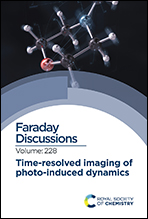Strong-field ionization of polyatomic molecules: ultrafast H atom migration and bond formation in the photodissociation of CH3OH†
Abstract
Strong-field ionization induces various complex phenomena like bond breaking, intramolecular hydrogen migration, and bond association in polyatomic molecules. The H-atom migration and bond formation in CH3OH induced by intense femtosecond laser pulses are investigated using a Velocity Map Imaging (VMI) spectrometer. Various laser parameters like intensity (1.5 × 1013 W cm−2–12.5 × 1013 W cm−2), pulse duration (29 fs and 195 fs), wavelength (800 nm and 1300 nm), and polarization (linear and circular) can serve as a quantum control for hydrogen migration and the yield of Hn+ (n = 1–3) ions which have been observed in this study. Further, in order to understand the ejection mechanism of the hydrogen molecular ions H2+ and H3+ from singly-ionized CH3OH, quantum chemical calculations were employed. The dissociation processes of CH3OH+ occurring by four dissociative channels to form CHO+ + H3, H3+ + CHO, CH2+ + H2O, and H2O+ + CH2 are studied. Using the combined approach of experiments and theory, we have successfully explained the mechanism of intramolecular hydrogen migration and predicted the dissociative channels of singly-ionized CH3OH.

- This article is part of the themed collection: Time resolved imaging of photo-induced dynamics


 Please wait while we load your content...
Please wait while we load your content...